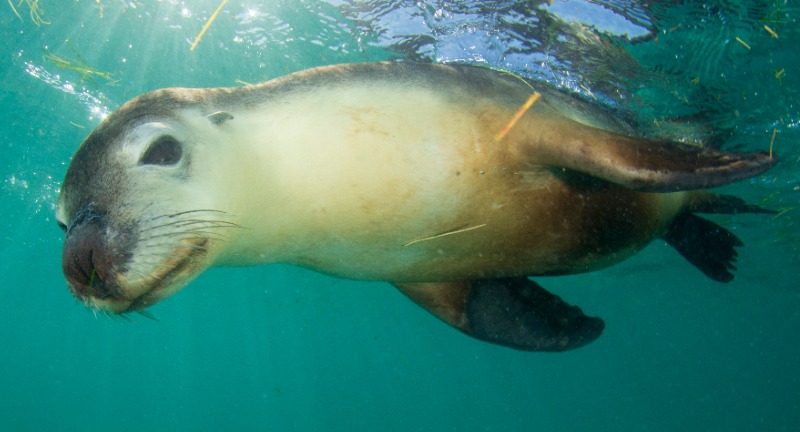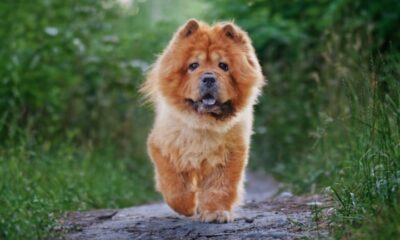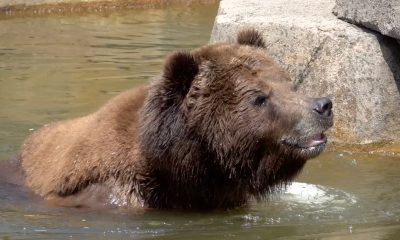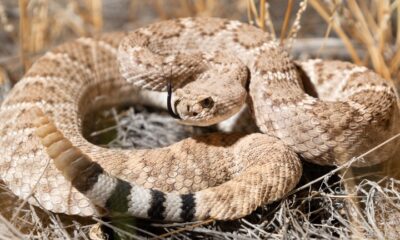NEWS
17 of the Rarest Creatures in Australia
Published
3 months agoon

Shutterstock
Australia is a land like no other and is home to an astonishing array of rare and unique wildlife found nowhere else on Earth. From secretive nocturnal parrots to critically endangered marsupials, these extraordinary creatures are a testament to the continent’s evolutionary isolation and biodiversity.
Let’s take a look at 17of Australia’s rarest animals, uncovering their fascinating stories and in some cases the urgent efforts to save them. Their survival is not just a battle for individual species but a fight to preserve Australia’s natural heritage for generations to come.
Gilbert’s Potoroo

Shutterstock
Gilbert’s Potoroo is Australia’s rarest marsupial, a small, nocturnal kangaroo-like creature that was presumed extinct until its rediscovery in 1994 in Western Australia. This herbivorous animal thrives in dense heathland but is highly vulnerable to habitat loss and predators. With fewer than 100 individuals remaining, captive breeding programs are crucial to its survival. Its delicate diet of truffle-like fungi makes its conservation particularly challenging, as its habitat must be carefully preserved. Gilbert’s Potoroo is a poignant reminder of the importance of ongoing habitat protection.
Leadbeater’s Possum

Shutterstock
The Leadbeater’s Possum, affectionately known as the “fairy possum,” inhabits the towering eucalyptus trees of Victoria’s Central Highlands. Its survival is precariously tied to old-growth forests, many of which have been lost to logging and bushfires. Known for its acrobatic leaps between trees, this marsupial is rarely seen, making it a symbol of the fragility of Australia’s ecosystems. Conservationists are working to establish reserves and halt deforestation in its habitat. The Leadbeater’s Possum serves as a critical flagship species for forest conservation in Australia.
Northern Hairy-Nosed Wombat

Shutterstock
The Northern Hairy-Nosed Wombat is one of the world’s rarest marsupials, with fewer than 300 individuals remaining in a single protected habitat in Queensland. Unlike its southern cousins, this wombat has distinctive whisker-like hairs on its nose and is slightly larger in size. Its population has been decimated by habitat destruction, drought, and competition with livestock. Conservation efforts, including predator-proof fences and supplementary feeding programs, have helped stabilize its numbers. However, its survival depends on expanding its habitat and addressing the impacts of climate change.
Lord Howe Island Stick Insect

Shutterstock
The Lord Howe Island Stick Insect, or “tree lobster,” is a giant flightless insect once thought extinct after invasive rats overran its habitat. Rediscovered in 2001 on Ball’s Pyramid, a rocky islet near Lord Howe Island, it has become a symbol of resilience. Efforts to breed the insect in captivity have been successful, with plans to reintroduce it to its native island. Its unique appearance and survival story have captivated scientists and the public alike. The Lord Howe Island Stick Insect is a testament to the power of conservation and the hope of species recovery.
Western Swamp Tortoise

Shutterstock
The Western Swamp Tortoise is Australia’s most endangered reptile, found only in seasonal swamps near Perth. These slow-moving reptiles are highly sensitive to changes in water availability and temperature. With a population of fewer than 50 in the wild, breeding programs have been crucial to their survival. Habitat restoration and predator control have also played key roles in conservation efforts. The tortoise’s survival is a stark reminder of how climate change impacts even the smallest creatures.
Christmas Island Frigatebird

Shutterstock
The Christmas Island Frigatebird is a magnificent seabird with a wingspan of up to two meters, known for its aerial acrobatics and dramatic courtship displays. Endemic to Christmas Island, it nests exclusively in its tropical forests, which are threatened by human development and invasive species. Its population is further strained by limited breeding sites and disturbances from human activities. Conservationists are working to protect its nesting areas and reduce threats from habitat destruction. The Christmas Island Frigatebird is a symbol of the fragility of island ecosystems.
Corroboree Frog

Shutterstock
The Corroboree Frog, with its striking black-and-yellow markings, is one of Australia’s most visually stunning amphibians. Found in alpine regions of southeastern Australia, it is critically endangered due to habitat loss, disease, and climate change. The chytrid fungus has devastated its population, making it one of the most high-profile victims of amphibian decline worldwide. Captive breeding and reintroduction programs are giving hope for its survival. The Corroboree Frog’s plight underscores the urgent need for amphibian conservation.
Spotted-Tail Quoll

Shutterstock
The Spotted-Tail Quoll, also known as the tiger quoll, is a large carnivorous marsupial that plays a vital role in its ecosystem. Found in forests along Australia’s east coast, it preys on small animals, helping to regulate prey populations. Habitat destruction and predation by invasive species have drastically reduced its numbers. Conservation programs aim to restore its habitat and curb threats from feral animals. The quoll’s survival is critical for maintaining the balance of its native ecosystems.
Eastern Curlew

Shutterstock
The Eastern Curlew is the largest migratory shorebird, known for its long, curved bill and haunting calls. It travels thousands of kilometers annually between Australia’s wetlands and its breeding grounds in Siberia. Habitat destruction along migratory routes and at key stopover points has caused severe population declines. Conservationists are working to protect vital wetland habitats and promote international cooperation for its survival. This majestic bird symbolizes the interconnectedness of global ecosystems.
Bridled Nailtail Wallaby

Shutterstock
The Bridled Nailtail Wallaby, named for the distinctive white “bridle” marking on its shoulder, was once widespread across eastern Australia. Thought extinct until its rediscovery in 1973, it now survives in small, protected areas. Conservation efforts focus on habitat restoration and protection from invasive predators. Captive breeding programs have also helped stabilize its population. This wallaby’s recovery story is a beacon of hope for endangered species.
Orange-Bellied Parrot

Shutterstock
The Orange-Bellied Parrot is a brightly colored migratory parrot that breeds in Tasmania and winters on mainland Australia. With fewer than 50 individuals in the wild, it is critically endangered due to habitat loss and competition with invasive species. Conservation programs include captive breeding, habitat restoration, and reintroduction efforts. Its distinctive green and orange plumage makes it a favorite among bird enthusiasts. Saving this parrot is a race against time to prevent its extinction.
Dainty Tree Frog

Shutterstock
The Dainty Tree Frog, also known as the graceful tree frog, is a small amphibian with a bright green body and striking golden eyes. Found in coastal Queensland, it thrives in wetlands and rainforests. Urban development and habitat fragmentation have significantly reduced its numbers. Conservation efforts focus on protecting its remaining habitats and raising awareness of its ecological importance. The frog’s delicate beauty underscores the value of preserving Australia’s diverse amphibian species.
Australian Sea Lion

Shutterstock
The Australian Sea Lion is the only pinniped species endemic to Australian waters. These playful and intelligent marine mammals breed on isolated islands along the southern coastline. Overfishing and entanglement in fishing gear have caused population declines, prompting strict protection measures. Marine sanctuaries and bycatch reduction programs are helping to stabilize their numbers. The Australian Sea Lion is an ambassador for marine conservation efforts.
Ghost Bat

Shutterstock
The Ghost Bat, named for its translucent wings, is Australia’s only carnivorous bat. It preys on small animals and roosts in caves across northern Australia. Habitat destruction and mining activities have reduced its numbers significantly. Conservation programs aim to protect its roosting sites and ensure sustainable land use. The Ghost Bat’s eerie appearance and vital ecological role make it one of Australia’s most fascinating species.
Plains-Wanderer

Shutterstock
The Plains-Wanderer is an enigmatic ground-dwelling bird that resembles a quail but is more closely related to shorebirds. It inhabits sparse grasslands and has evolved a unique ecological niche. Habitat loss due to agricultural expansion has made it critically endangered. Efforts to protect and restore its grassland habitat are underway, along with breeding programs to bolster its numbers. The Plains-Wanderer is a symbol of the need for sustainable agricultural practices.
Shy Albatross

Shutterstock
The Shy Albatross, named for its reserved nature, is Australia’s only endemic albatross species. It breeds on Tasmania’s offshore islands and spends most of its life gliding over the Southern Ocean. Bycatch in fishing operations and climate change threaten its population. Conservation efforts include protecting nesting sites and using bird-safe fishing practices. This majestic seabird is a symbol of the vast and interconnected ocean ecosystem.
Wallum Sedge Frog

Shutterstock
The Wallum Sedge Frog is a small, brightly colored amphibian that lives in acidic wetlands along Australia’s east coast. Urban development and habitat destruction have placed it at risk of extinction. Conservation programs focus on restoring wetlands and mitigating the impacts of human activities. The frog’s survival is intricately tied to its unique environment, making it a key indicator of wetland health. Its plight highlights the importance of preserving Australia’s fragile aquatic habitats.
Conclusion

Shutterstock
Australia’s rare animals are living treasures, each playing a crucial role in the intricate web of life that defines the continent’s unique ecosystems. The survival of these species depends on continued conservation efforts, greater awareness, and a collective commitment to protecting their habitats. By taking action now, we can ensure these remarkable creatures thrive for future generations to admire and cherish. Preserving their existence is not just an environmental responsibility but a testament to humanity’s respect for the wonders of the natural world.
More Amazing Animals+
-


25 Reasons Why English Bulldogs Are the Ultimate Couch Companions
-


25 Ways Whippets Combine Speed and Sweetness
-


25 Reasons to Choose the Chow Chow as Your Pet
-


25 Surprising Facts About Cocker Spaniels
-


25 Reasons to Love the Brussels Griffon
-


25 Things That Make Great Danes Gentle Giants
-


25 Traits That Set Belgian Malinois Apart as Incredible Working…
-


Danish Royal Life Guards escort duck family to Copenhagen harbor
-


Boris the bear beating the heat at the Milwaukee County…
-


22 Dangerous Animals to Watch Out for in Arizona
-


21 Key Points to Ponder Prior to Getting a Dog
-


25 Ways Chinese Cresteds Are Uniquely Beautiful
